Newhart
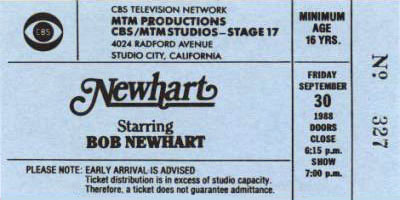
I once asked Kim LeMasters, who ran programming for several years at CBS, if anyone ever came in, pitched him an idea and he bought it on the spot. He said it had happened twice. One was Magnum, P.I. and the other was Newhart. In both cases, the “pitcher” (in the case of Newhart, it was Barry Kemp) came in with a star the network wanted to work with and a format that was fully developed and perfect for that star. And the idea of this show, with Bob running an inn and putting up with odd neighbors and occupants, was pretty darn ideal for Mr. Newhart.
As you can see from the above ticket, it was done on Stage 17 at the CBS Radford lot, which was the same place where Bob did The Bob Newhart Show for 142 episodes. This one lasted 184, which must be some kind of industry record for one-two punches. (To balance, Newhart’s next sitcom — the one I worked on, of course — lasted 33 episodes, and the one after that lasted 22.) The early episodes of Newhart were done on videotape, as opposed to film. Bob, it turned out, decided he didn’t like the look of tape so they converted to film. If you think that sounds silly…hey, you go argue with 184 episodes.
A lot of people think the last one, in which it turned out the entire series was a dream of the character Bob played in his previous series, was one of the most daring, brilliant ideas ever on television. It’s certainly a contender.
All’s Fair
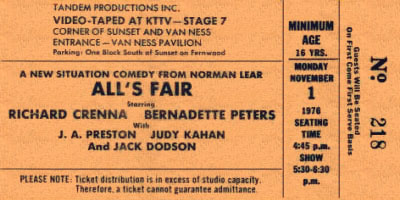
The premise of All’s Fair — a show which almost no one remembers — was that Richard Crenna played a very conservative political columnist in Washington, and Bernadette Peters played his lady friend who was, of course,very liberal. I only watched a few episodes but it seemed to me — like most political discussions in today’s non-sitcom world — a little too pat, in terms of everyone mouthing knee-jerk positions and coming quickly to realize the flaws in their position. Unlike the real world (except at the residence of James Carville and Mary Matalin), Crenna and Peters usually managed to find a way to resolve or compromise their arguments before bedtime. This show lasted for a year and went through a few storyline changes (and the addition to the cast of Michael Keaton) but it never quite caught on.
Big Eddie
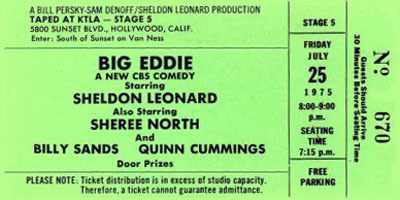
Sheldon Leonard spent most of his early acting career playing gangsters, race track touts and other shady individuals. In the sixties, he turned to producing and directing but could always make time for the occasional mobster role. In 1975, he even starred in a short-lived situation comedy about a former tough guy. Big Eddie featured him as Eddie Smith…and one suspects the innocuous surname was chosen to make sure there was no connect to any ethnic group. Smith had made the move from the rackets to an almost-respectable life operating a New York sports arena. Past associates and old, unfinished business from his past life had an annoying way of turning up, though all Eddie wanted to live an honest life with his spouse (a former stripper played by Sheree North) and their granddaughter (played by 12-year-old Quinn Cummings, who would go on to steal the movie, The Goodbye Girl, two years later). Eddie also had a thing about bubble baths and could often be found luxuriating in one.
The show went on the air August 23 of 1975 with solid writing/producing from Bill Persky and Sam Denoff, who’d worked with Leonard on The Dick Van Dyke Show among other triumphs. CBS didn’t seem to have a lot of faith in it. After only three broadcasts, they moved it to another night — never a promising sign — and wound up shutting it down after only ten episodes. It was a bad year for Persky and Denoff, who were simultaneously launching a sitcom for NBC called The Montefuscos. They made thirteen of those but the network only aired eight or nine of them.
I remember Big Eddie as a pleasant show that kept hitting the same note over and over…Eddie trying to convince people that he’d changed and had put the old days behind him. I also seem to recall that it was never quite clear how nefarious those old days had been; like early on, the idea had been that he’d been the kind of hood who had people rubbed out but someone — the network or the producers or someone — had said, “No, then he’d be a murderer who got away with it and audiences wouldn’t like him.” So they softened his backstory down to the point where he was almost a businessman who’d occasionally dealt with the wrong people, thereby removing what might have been more interesting about Eddie Smith. Still, it was a nice, albeit short star turn for Sheldon Leonard, who was very good in the role. He didn’t do much acting after that but did manage to get cast as J. Edgar Hoover in a TV-Movie just before he retired. That might have been the sleaziest character he every played.
Rhoda
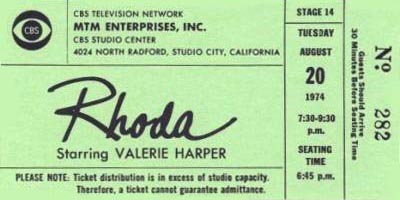
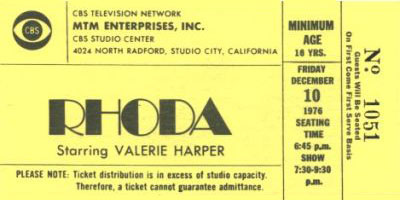
Valerie Harper appeared in (and darn near stole) the first episode of The Mary Tyler Moore Show in 1970 and many thereafter. Her Jewish, agonizingly-single character of Rhoda Morganstern provided a nice contrast to Mary’s white bread niceness. And after veteran character actress Nancy Walker began appearing occasionally to play Rhoda’s mother, you had another sitcom just waiting to happen. Finally, in 1974, it spun off on its own, largely under the creative direction of writer-producers Lorenzo Music and David Davis.
Harper and Walker were at the center of it all, joined by Julie Kavner as Rhoda’s younger sister, Harold Gould as her father, and a number of characters who were probably intended as regulars but didn’t stick around long. This included David Groh, who played a man who wooed and eventually wed the title character. Though the wedding episode drew monster ratings, the show lost a great deal of its edge with a married Rhoda. Eventually, they separated and the show never quite regained its pre-marital momentum. In all, it lasted five seasons.
The most interesting character on the show, and maybe the most popular, was never seen. It was Carlton, the perpetually-inebriated doorman of the building in which Rhoda lived — a man heard primarily over that building’s intercom. He did make a few on-camera appearances but something always got in the way, preventing the audience (and even Rhoda) from seeing his face. Carlton was so popular that when Rhoda got married, the producers made sure the newlyweds made their new home in the same apartment house. (One of those producers, Mr. Music, provided the voice of Carlton. In 1980, Carlton was finally seen — in the pilot for what was intended as a weekly, prime-time animated program, Carlton, Your Doorman. The one episode produced won an Emmy as that year’s Best Animated Special but failed to become a series.)
Chicken Soup
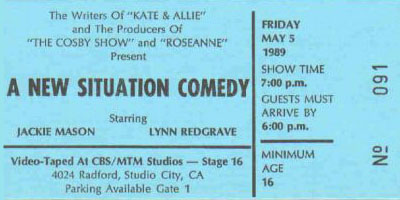
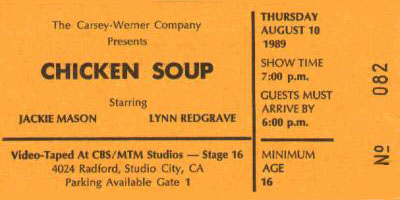
In the late eighties, comedian Jackie Mason made a comeback of sorts with a one-man show that played Broadway and theaters around the nation. Entitled, The World According to Me, it was kind of a “best of” of stand-up material he’d been performing for several decades and it was very funny. ABC grabbed him up for a situation comedy that debuted on September 12, 1989 under the name, Chicken Soup. As you can see from the first ticket above, they were taping in May without having settled on that name.
On Chicken Soup, Mason played Jackie Fisher, a single Jewish man who stumbles into an odd relationship with an Irish-Catholic widow with three children. Lynn Redgrave played the widow and critics were almost unanimous in remarking how unconvincing the stars were as a couple. It was difficult to imagine the on-screen Jackie Mason being in love with anyone but certainly not Ms. Redgrave. Never have the co-stars of a situation comedy seemed so remote from one another. Only when the scripts allowed Mason to sneak in a bit of his stand-up style did the series show any life. But that didn’t happen often enough for the show to survive and it only ran eleven episodes.
Mary Tyler Moore Show, The
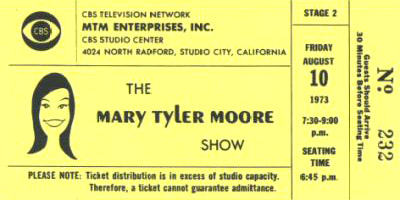
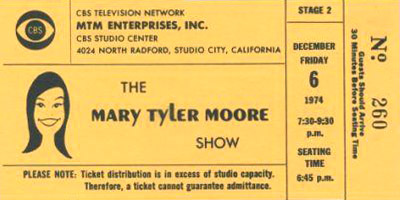
If you’d attended a filming of Ms. Moore’s classic sitcom — and sadly, I never did — you would probably have heard a warm-up performed by writer Lorenzo Music, who later gained fame as the voice of Carlton the Doorman (on Rhoda) and Garfield the Cat. For a time, shows produced by the MTM company dominated CBS Studio Center in the valley — a facility built on land that had once housed Mack Sennett’s second studio. Sennett erected it just as his business was dying out due to changing audience tastes, as well as the coming of sound film. The property was sold in a bankruptcy hearing and went through several owners before becoming Republic Studios, birthplace of many a movie serial and “B” western. It had moved into renting out space to others by 1963 when CBS leased the place, eventually buying it outright.
The Mary Tyler Moore Show was the sitcom that changed seventies’ television. As is well known, the network was not fond of the script and format devised by writers James Brooks and Allan Burns, and the advance testing of the show predicted a sure-fire flop. Less well known is how the show came to be at all. After The Dick Van Dyke Show, Mary Tyler Moore had attempted to establish a motion picture career. Thoroughly Modern Millie was a modest success but then What’s So Bad About Feeling Good? and Don’t Just Stand There suggested that ticket buyers were not racing to see Laura Petrie on the big screen. A disastrous attempt at a Broadway musical (Breakfast at Tiffany’s) also helped convince her that her place was on television. And what really convinced her (and CBS) was a 1969 special in which she reteamed with her former co-star. Dick Van Dyke and the Other Woman was an hour of songs and sketches that earned rave reviews and strong ratings.
It got Mary the offer she needed to return to the world of situation comedy and soon, she not only had a hit show but a production company that produced many of them, including spin-offs Rhoda and Phyllis, as well as acclaimed, unrelated sitcoms including The Bob Newhart Show, WKRP in Cincinnatti, The Tony Randall Show and many more. After The Mary Tyler Moore Show left the air in 1977, she again tried movies and Broadway with mixed success but again fled back to television. She starred in Mary (1978), The Mary Tyler Moore Hour (1979) and another show called Mary (1985).
Don Rickles Show, The
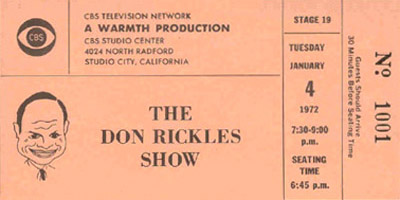
There was a time when network executives were sure that Don Rickles could be the star of a big hit TV series if only someone could find the right vehicle. In a very short time, Mr. Rickles went through more vehicles than Jay Leno has in his garage. There were pilot scripts that were filmed, pilot scripts that were not filmed, specials and even a couple of shows that made it onto the air. One attempt in 1972 basically tried to turn him into Dick Van Dyke but with a slight twist. Rickles, someone said to someone else, would articulate the anger that we all feel in day-to-day problems. So one episode was about him trying to get his TV repaired and running into bureaucracy and insane people. Another was about him trying to get his car repaired and running into bureaucracy and insane people…and so on. Otherwise, it was pretty much The Dick Van Dyke Show but without the magic.
The Rickles sitcom took place in a living room set that looked like it had been furnished by the same people who designed Rob and Laura Petrie’s home. Don Robinson had a lovely wife (Louise Sorel) who kinda reminded you of Laura, a daughter (Erin Moran) who was a lot like Ritchie, and a best friend (Robert Hogan) who had all the traits of Jerry Helper. Instead of writing The Alan Brady Show, he worked in an ad agency and instead of New Rochelle, he lived in Long Island, New York. Sheldon Leonard, who had executive produced The Dick Van Dyke Show, executive produced The Don Rickles Show. Mr. Leonard also did the audience warm-up, at least at the filming I attended, and I wrote about it in this article. In it, I also note that when Leonard wrote his autobiography years later, he discussed every TV show with which he was involved except that The Don Rickles Show went curiously unmentioned.
The series was quickly forgotten after its thirteen weeks were up. And judging from the lack of promotion it received and the fact that CBS moved it around between several less-than-promising time slots, it would seem everyone had given up on this one long before the final episode aired. Rickles wouldn’t find a decent format for television until four years later and C.P.O. Sharkey…and even that only lasted two years.
Mr. Belvedere
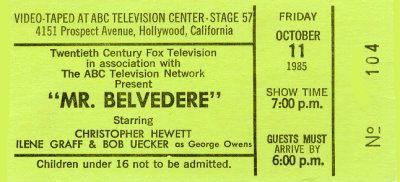
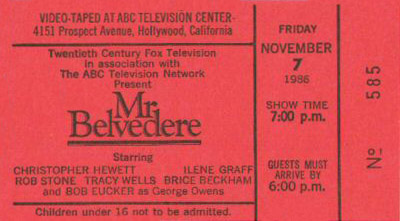
I always thought Mr. Belvedere was a stealth TV show. It was on for six seasons with respectable ratings but all during that time, I never heard one person mention it, either on TV or in my presence. Bob Uecker would go on the Carson show and casually mention his main line of work before lapsing into very funny tales of his days in baseball. (Uecker claimed to have been a lousy player who never got any respect. He didn’t get a lot in his TV career, either. On the second of the above tickets, his name is misspelled.) I don’t recall seeing any of its other stars anywhere. In fact, the only time I can recall any of my friends mentioning it was an actor pal who was up for a sitcom and who said he hoped it would be like Mr. Belvedere — a show that stays on a long time and earns its cast tons of money, and the network keeps not canceling it because even they forget it’s on. ABC Television Center at Prospect and Talmadge is in the Los Feliz area, where a lot of movie studios were built back in the silent days. This one was originally Vitagraph Pictures, but it went through many hands and remodels before becoming ABC’s main production facility in L.A. In 2000, it became a secondary site to a new studio built in Glendale, but some soap operas still tape there.
New Dick Van Dyke Show, The
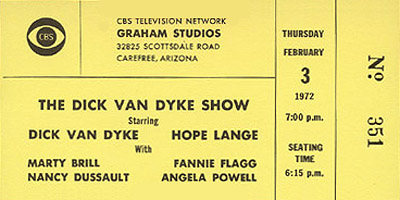
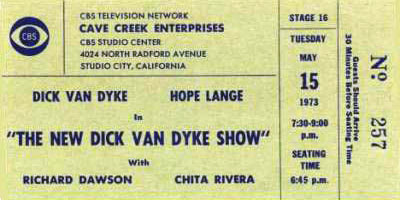
The original Dick Van Dyke Show left the CBS airwaves in 1966 and its two main stars — Mary Tyler Moore and Mr. Van Dyke — plunged into movies, both with disappointing results. In 1969, they co-starred in a variety special, Dick Van Dyke and the Other Woman, that led to offers to return full-time to television. Dick said no and returned to his new home in Arizona. Mary said yes and The Mary Tyler Moore Show went on the air and became a large hit. This prompted CBS to up its offer to Van Dyke…but Dick was happy in Arizona and not interested in returning to L.A. to do a new series. The solution was to remodel and upgrade a studio near Van Dyke’s new desert home and to do the show there…the first network prime-time TV show ever filmed in Carefree, Arizona and (one suspects) the last.
It was titled The New Dick Van Dyke Show though they sometimes omitted the “new,” as you might note in the tickets above. There’s no “new” on the second season ticket but there is on the third season ticket. The first two years were produced in Arizona with Carl Reiner running things, and found Dick playing Dick Preston, a talk show host at a mythical Phoenix TV station, KXIU. Hope Lange played his spouse and suffered the unenviable fate of having most of America say, “They don’t have the same chemistry he had with Mary.” Well, at least the guys at CBS said that, and as her role was downplayed and more of the action centered around the talk show, rumors circulated that Ms. Lange wanted out.
She stayed but one attempt to build an installment more around her relationship with Dick drove Carl Reiner away. Near the end of the second season, CBS rejected an episode in which the Prestons’ young daughter accidentally walked into the bedroom of Mommy and Daddy while Mommy and Daddy were having sex. This happened off-camera and Reiner insisted the scene was tastefully done, very funny and that it had been properly vetted by consultants whose opinions should be honored. CBS refused, the episode never aired and Reiner quit. The series itself was almost cancelled then but Van Dyke had a firm three-year contract and CBS had a hole in its schedule that seemed to need the show.
For what turned out to be its final season, the no-longer-new New Dick Van Dyke Show moved to Hollywood where a new creative team did a remodelling job. Apart from Ms. Lange and Angela Powell (the actress who played their daughter), the entire supporting cast was let go. Dick Preston became an actor on a daytime soap opera, and new cast members were added. They included Richard Dawson (who played a TV cooking host not unlike Graham “The Galloping Gourmet” Kerr), Chita Rivera, Barry Gordon, Henry Darrow, Barbara Rush and Dick Van Patten. Ratings went up but Van Dyke’s interest in the whole project went down and at the end of the season and after completing 72 episodes, he announced he was done with it and with series television. And he never did another series again except for Van Dyke and Company (1976), The Van Dyke Show (1988) and Diagnosis Murder (1993-2001).






